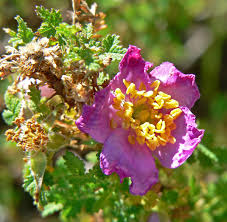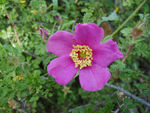Baja rose
| Baja rose |
|---|

|
| Scientific Classification |
|
| Scientific Name |
|
Rosa minutifolia... |
| Image Description |
Rosa minutifolia, more commonly know as the baja rose or the small leaved rose, is a shrub that is native to California and Baja California. Its bloom period lasts from January to June. The Baja Rose is recognized in California as endangered.[1]
Body Design
The Baja Rose is a Dense shrub or thicket-forming perennial, found in chaparral plant communities. Stems: Stems are low and arching, with many, generally unpaired, straight, slender prickles measuring 2-12mm in length. Leaves: The leaves of Rosa minutifolia are small with the terminal leaflets measuring just 3-6mm long and wide.the Leaves are on it are round. they are widest near the middle. Leaf axis is finely short-hairy and sparsely glandular. Leaflets are hairy and are arranged in 5-7. Flowers: Inflorescences are generally one-flowered, pedicels are hairy and glandless, and measure to about 2-10mm in length. Flowers have a hypanthium to around 3mm wide. Sepals have toothed lateral lobe, with the tip generally being about equal to the body. Flowers typically contain about 10 pistils each. the petals are deep pink, pale pink, or rarely white. Flowers appear in late winter.Fruit: Fruit shape is typically spherical, about 5mm in width. Sepals persistent, erect to spreading; achenes unknown.the rose is now extintive in the wild.
Life Cycle
Roses are perennials that last for many years growing and blooming during the spring and summer and then going dormant during the fall and winter. Roses start out as seeds, but mature plants repeat this annual life cycle as long as they are healthy and growing conditions are favorable. Most gardeners skip the seeds and buy bare root roses/potted roses for their gardens. Bare root roses are sold in packages and include dormant roots and stems which must be soaked and then planted. Potted roses are already established in soil and just need to be transplanted into a garden by early spring. Rose plants must be pruned each spring to insure the best blossoms. As with most flowers, the rose's fragrant blooms are meant to attract bees and other pollinators. As the bees flit from flower to flower, they leave behind pollen particles. These attach to the stigma, the sticky opening to the ovary. Once pollinated, seeds are produced inside fruits called rose hips. These are eaten by animals, causing the seeds to be dispersed. After the blooming season is over, the rose enters its dormant phase. Gardeners in cold climates usually protect their plants by covering them with mulch, straw or special structures called rose cones. The plants remain covered until spring when the life cycle begins again.
Ecology
The Baja rose generally grows from the red clay in baja California. It thrives with coastal sage scrub in the desert areas and doesn't need a lot of water, [2] It can survive up to nine months without water. When rain comes the plant responds with rapid growth, flowering, and setting seeds. This is possible beause there is basically no frost where the plant grows. The plant is very little known outside of California, only being found in a few private and botanical gardens. Rosa minutifolia's flower color is pink, has a fragrance which attracts bees and is edible. [3]
Video
Video description here....
References
- ↑ Rosa minutifolia Calflora. Web. Accessed April 24, 2018. accessed. Unknown Author.
- ↑ Wilson, Bert. Rosa minutifolia Las Pilitas Nursery. Web. Accessed April 24, 2018.
- ↑ Smith, Lawrence. The Xerophytic Rose Pacific Horticulture.org. Web. Accessed April 24, 2018.

